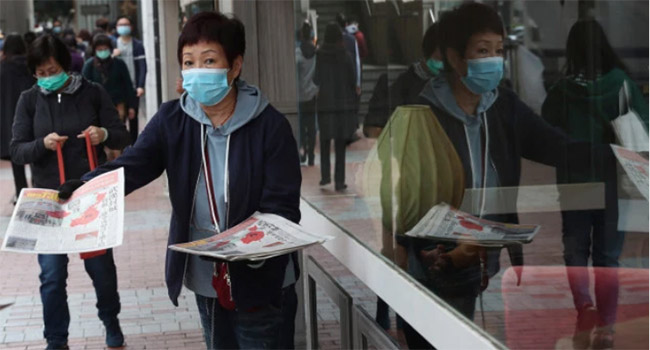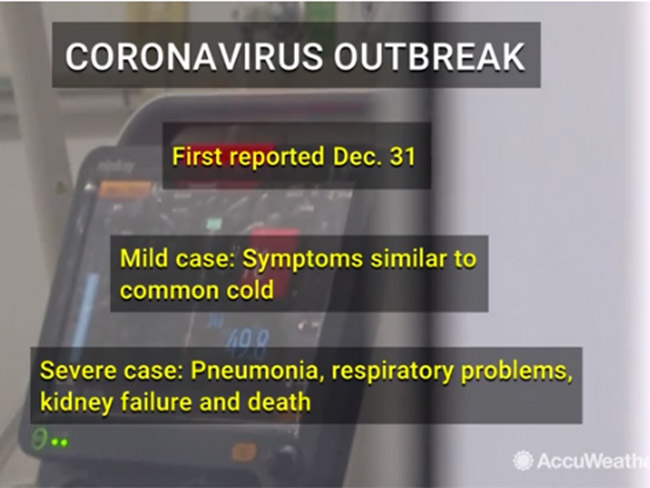Amid one of the world's largest annual human migrations, coronavirus continues to grow.

By Adriana Navarro, AccuWeather.
An entire city in China is essentially on lockdown this week, as officials try to get a handle on the Coronavirus outbreak. American warning forecaster AccuWeather reports: Here's what you need to know.
While winter is typically flu season for the northern part of China, a new virus has taken hold of the nation. The coronavirus was identified in an outbreak of respiratory illnesses in Central China's Hubei province, specifically in its capital city of Wuhan, according to the Center for Disease Control and Prevention (CDC).
Symptoms of this virus include a fever, coughing, shortness of breath and other symptoms similar to a cold. The virus can cause lower respiratory tract illnesses, such as pneumonia or bronchitis, according to the CDC. While some cases have reportedly brought nothing worse than a cold, other cases have had dire consequences.
At least 56 people have died in China from the virus, and there have been an estimated 1,975 cases in the country, according to the Associated Press. A handful of other cases have been reported in nearby areas including Thailand, Australia, Japan and Hong Kong. A few cases have been reported in the U.S. as well.

In Wuhan the factories are mostly shut down.
"Early on, many of the patients in the outbreak in Wuhan, China, reported some link to a large seafood and animal market, suggesting animal-to-person spread," the CDC said. However, the same does not hold true for a growing number of patients, indicating a person-to-person spread now.
In response to this, China has expanded a travel lock down in the central part of the country, including 12 cities near the center of the outbreak, according to the New York Times. This comes amid one of the world's largest annual human migrations as people looked to go home or visit relatives for the Chinese New Year as the lunar calendar flips to the Year of the Rat. Last year alone, about 415 million people traveled for the holiday, according to Statista.

The New York Times estimates these travel restrictions will affect about 35 million people – nearly the population of Canada.
Authorities in Beijing and other cities canceled public celebrations and other Lunar New Year events in response to the threat from the virus, according to the Associated Press.
In the past, strains of human coronaviruses predominantly circulated in the transition from winter to spring, notably January into February, according to an online journal published by the National Center for Biotechnology Information. The CDC also notes that human coronaviruses are more common in the winter and fall months. However, little is known about how exactly this new strain spreads. The CDC is currently still investigating the outbreaks.
With other strains of coronaviruses such as MERS and SARS, it has been thought that they spread through respiratory droplets produced when an infected person coughs or sneezes, the CDC said.
The CDC advises for people to avoid close contact with others who are sick; clean and disinfect frequently touched objects and surfaces; and for people to wash their hands. They recommend for people who are already sick to stay home.
These prevention tips can be especially important for families who were able to travel for the holiday and people gathering indoors for warmth in the cold weather.
The U.S. State Department has ordered all American workers at the United States Consulate in Wuhan to evacuate, the United States Embassy told the New York Times on Saturday.
At least four cases of the virus have been confirmed in the United States, all from people who had been visiting China. The first case involves a 30-year-old man from Washington state who had traveled from Wuhan and started developing symptoms after his trip.
The second case was confirmed on Friday, involves a 60-year-old Chicago woman who had returned home to the city from Wuhan, China. She is currently in isolation in a hospital and in stable condition, according to state officials.
"We understand that some people are worried about this virus and how it may impact Americans," Dr. Nancy Messonnier said in a CDC press briefing on Friday. "While this situation poses a very serious public health threat, CDC believes that the immediate risk to the U.S. public is low at this time, but the situation continues to evolve rapidly."
Two additional cases were confirmed over the weekend in Southern California, according to the AP.




